This Post may contain affiliate links, when you purchase through links on our site, we may earn an affiliate commission at no extra cost to you. Here’s how it works.
In the realm of home entertainment, achieving the perfect audio experience is just as crucial as having a high-definition display.
Table of Contents
ToggleSurround sound systems have revolutionized how we perceive sound in movies, music, and gaming, creating an immersive auditory landscape that transports us into the heart of the action.
However, setting up surround sound speakers isn’t merely about scattering them randomly around the room; it’s an art form that requires precision and consideration for optimal performance.
Let’s embark on a personalized journey and discover where To Place Surround Sound Speakers.
Understanding the Basics of Sound System
Before delving into placement specifics, it’s essential to grasp the basics of surround sound configurations.
The most common setups include 5.1, 7.1, and even more advanced systems like 9.1 or 11.1.
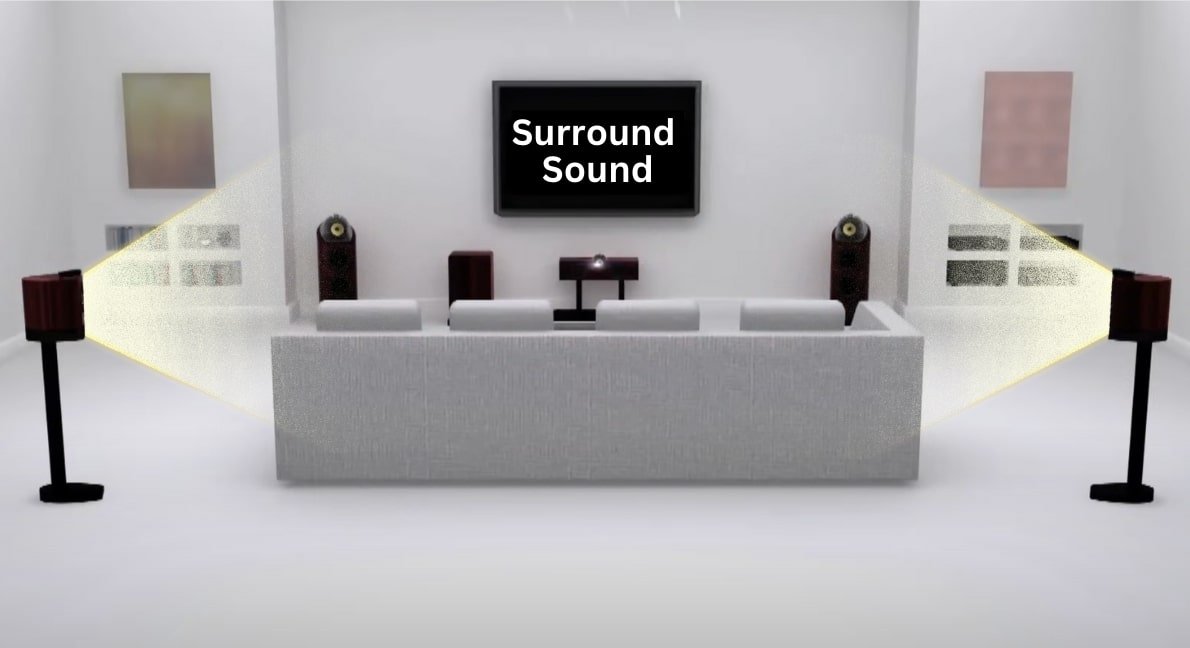
The numbers represent the quantity of speakers and subwoofers in the system.
For instance, a 5.1 system consists of five speakers (front left, center, front right, surround left, and surround right) and one subwoofer.
Crafting Your Soundscape: The Essentials
Before delving into the placement specifics, let’s outline the basic components of a surround sound system. Traditionally, surround sound setups comprise:
- Front Speakers: Responsible for delivering dialogue and primary sound effects.
- Rear Speakers: Enhance the immersion by delivering ambient noise and surround effects.
- Center Speaker: Anchors dialogue and crucial sound elements to the screen.
- Subwoofer: Adds depth and richness to low-frequency effects, such as explosions and deep bass tones.
Where To Place Surround Sound Speakers for better experience?
Connecting Surround sound speakers to a TV or Big screen, you can experience extensive sound quality.
The Center of Attention: Front and Center
Imagine yourself seated in your home theater or living room, eyes fixed on the screen.
The center channel speaker plays a pivotal role in delivering clear dialogue and central sound effects.
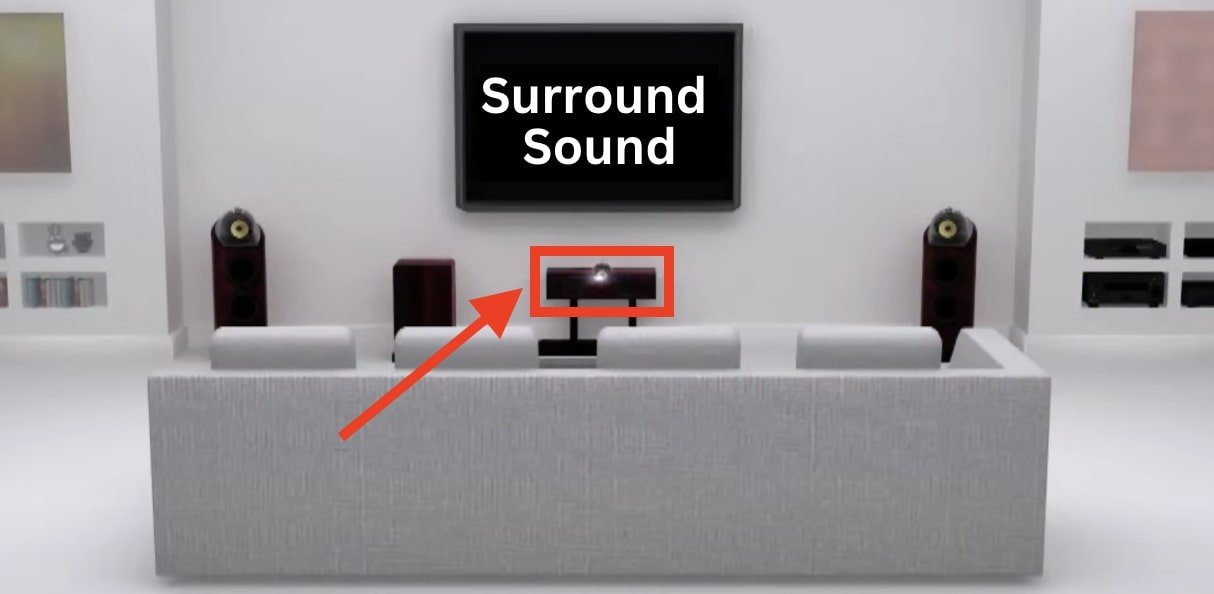
Ideally, it should be positioned directly above or below your display, at ear level when seated.
This ensures that dialogue remains crisp and intelligible, anchoring the sound to the on-screen action.
Flanking the Scene: Front Left and Right
The front left and right speakers serve as the backbone of your audio setup, delivering stereo sound and anchoring the sonic panorama.
Position them equidistant from the center channel speaker, forming an equilateral triangle with your seating position.
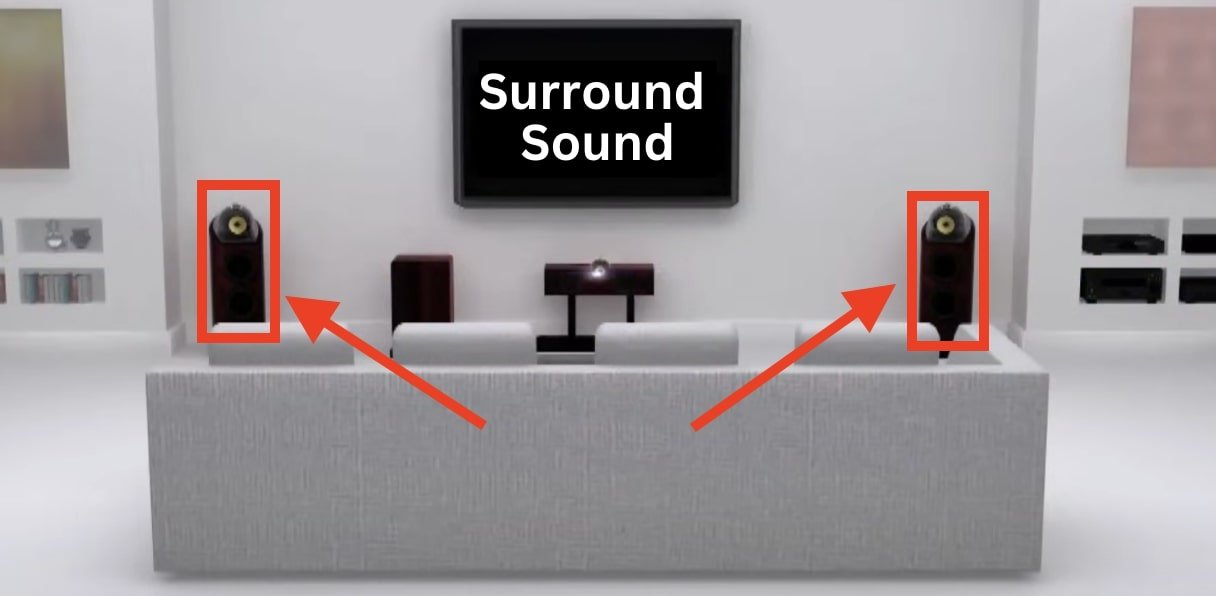
Angle them slightly inward to direct sound towards the audience, optimizing stereo imaging and immersion.
Enveloping the Audience: Surround Left and Right
Now, let’s shift our focus to the surround speakers, which envelop the audience in a blanket of ambient sound and immersive effects.
Ideally, these speakers should be placed slightly behind the primary seating area, elevated above ear level.
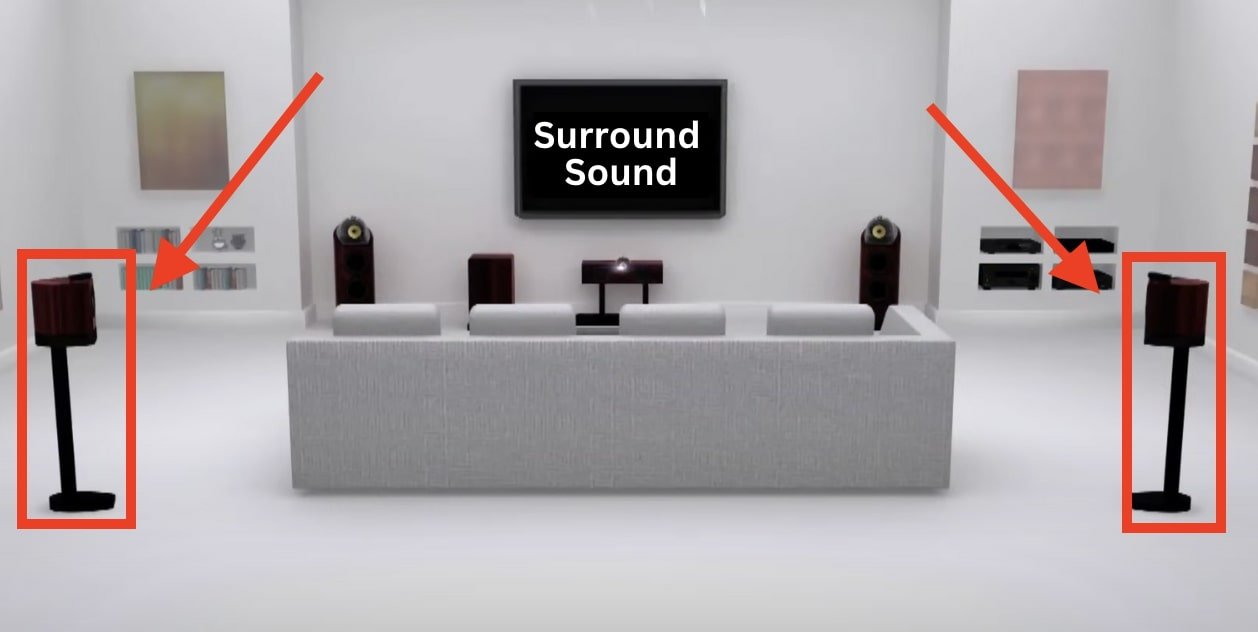
Angle them towards the listening area, ensuring that they create a diffuse sound field without overpowering the front channels.
This placement enhances the sense of envelopment while maintaining a balanced audio experience.
The Low-End Foundation: Subwoofer Placement
No surround sound system is complete without a robust subwoofer to handle low-frequency effects and bass reproduction.
Unlike traditional speakers, subwoofers are less location-sensitive due to the omnidirectional nature of bass frequencies.
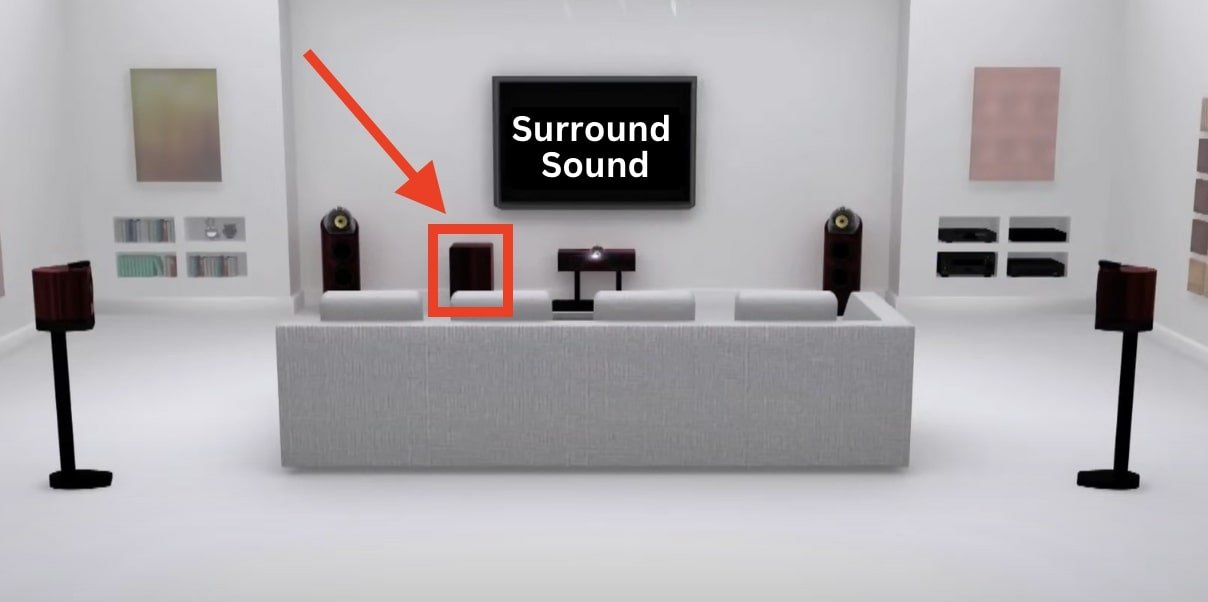
However, placing the subwoofer near a room corner or along the front wall can enhance bass response by leveraging room acoustics.
Experiment with different placements to find the sweet spot where bass is impactful without becoming boomy or overwhelming.
Room Considerations and Adaptations
Every room possesses its unique acoustic characteristics, influencing sound propagation and resonance. Consider these factors when fine-tuning your setup:
- Room Size: In smaller spaces, placing rear speakers directly behind the OLP might not be feasible. In such cases, opt for wall mounting or consider compact satellite speakers.
- Room Shape: Irregularly shaped rooms may necessitate creative solutions to maintain balanced sound distribution. Experiment with speaker placement to mitigate any acoustic anomalies.
- Furniture Arrangement: Sofas, chairs, and other furnishings can either absorb or reflect sound waves, impacting audio quality. Avoid obstructing speaker paths with large furniture pieces.
5.1 Surround Sound Speaker Placement:
5.1 surround sound systems consist of five speakers and one subwoofer, providing a balanced audio experience suitable for most home theaters.
- Front Left and Right Speakers: Position these speakers at equal distances from the primary listening area, ideally forming an equilateral triangle with the listener. Place them at ear level when seated, flanking the TV or screen.
- Center Speaker: Place the center speaker either directly above or below the display, aligned with the listener’s ear level. Tilt it upward if positioned below the screen to ensure clear dialogue projection.
- Rear Speakers: These speakers should be placed behind the primary listening area, either directly behind or slightly to the sides. Angle them inward towards the center for optimal surround sound effects.
- Subwoofer: Subwoofers reproduce low-frequency effects, so they’re less directional. Place the subwoofer along the front wall or in a corner to maximize bass response without overpowering the other speakers.
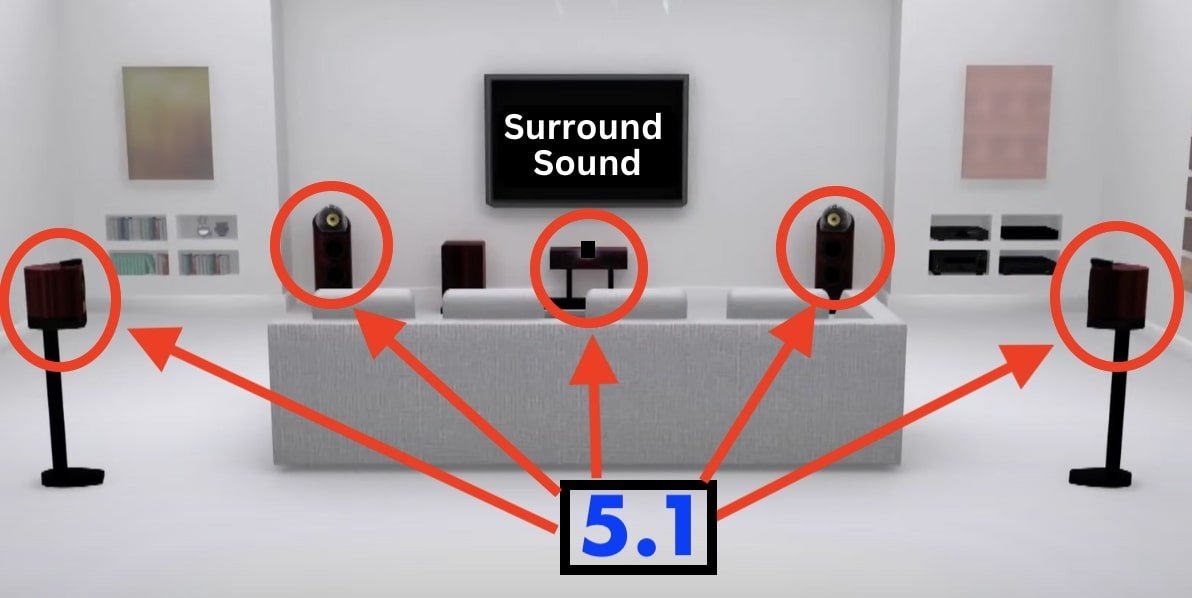
7.1 Surround Sound Speaker Placement:
7.1 surround sound systems incorporate seven speakers and one subwoofer, offering a more immersive audio experience with additional rear speakers.
- Front Left and Right Speakers: Follow the same placement principles as in a 5.1 setup, positioning them at ear level and equidistant from the primary listening area. Ensure they flank the screen for optimal stereo imaging.
- Center Speaker: Maintain alignment with the display, either above or below it, and adjust the tilt if necessary to direct sound towards the listener. The center speaker remains crucial for clear dialogue reproduction.
- Side Speakers: Introduce two additional speakers to the sides of the primary listening area, aligned with the listener’s ear level. These speakers enhance lateral sound effects, contributing to a more immersive experience.
- Rear Speakers: In a 7.1 setup, place two rear speakers behind the primary listening area. Aim for symmetry and ensure they’re equidistant from the listener, contributing to a 360-degree soundstage.
- Subwoofer: As with a 5.1 system, position the subwoofer along the front wall or in a corner to maximize bass response. Experiment with placement to achieve a balanced low-frequency presence without overwhelming the other speakers.
7.2 Surround Sound Speaker Placement:
7.2 surround sound systems expand upon the 7.1 setup by incorporating two subwoofers for enhanced bass performance, ensuring a more visceral audio experience.
- Front Left and Right Speakers: Maintain the standard placement guidelines, positioning them at ear level and equidistant from the primary listening area. These speakers serve as the foundation of your audio setup, delivering clear, detailed sound.
- Center Speaker: As the anchor for dialogue and critical sound elements, the center speaker should remain aligned with the display and adjusted for optimal projection towards the listener.
- Side Speakers: Place two side speakers at ear level, flanking the primary listening area. These speakers contribute to lateral sound effects, enriching the immersive audio experience.
- Rear Speakers: With two rear speakers behind the listening area, immerse yourself in a 360-degree soundstage. Ensure symmetrical placement and adjust the angle for optimal surround sound dispersion.
- Dual Subwoofers: Introduce a second subwoofer to the system for enhanced bass response and improved low-frequency distribution. Experiment with placement to minimize bass nulls and achieve balanced, impactful bass throughout the room.
Conclusion:
Mastering the placement of surround sound speakers is akin to orchestrating a symphony—each component plays a crucial role in delivering an unforgettable auditory experience.
By following these guidelines on where to place surround sound speakers and embracing a spirit of experimentation, you’ll unlock the full potential of your home theater system, immersing yourself in a world of unparalleled audio delight.
So, grab your popcorn, dim the lights, and prepare to be swept away on a cinematic journey like never before. Your personalized symphony awaits.
